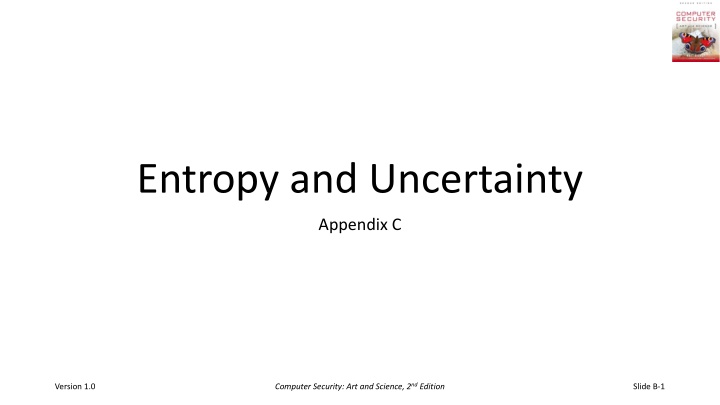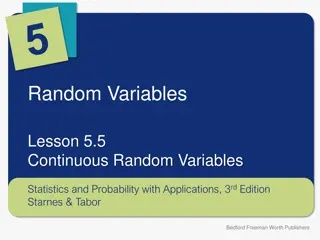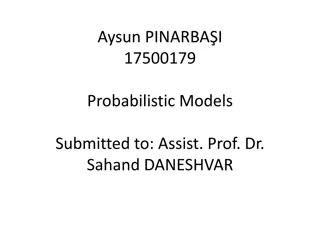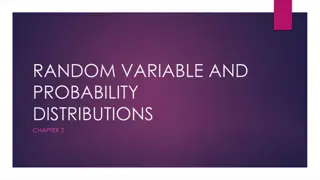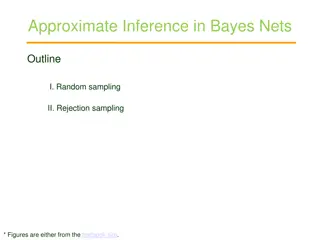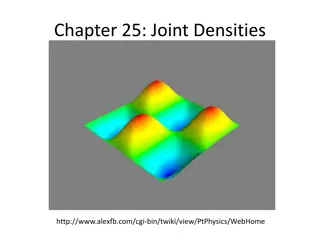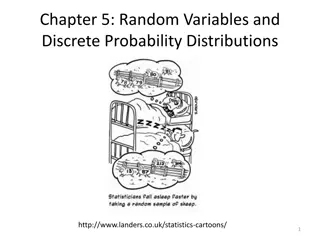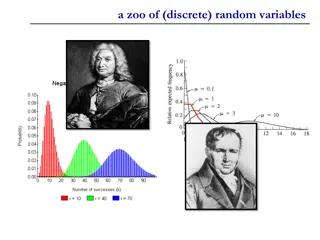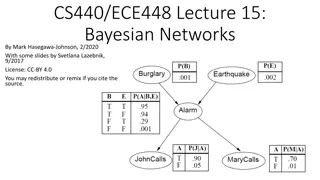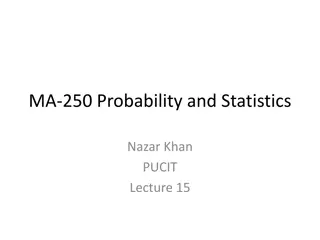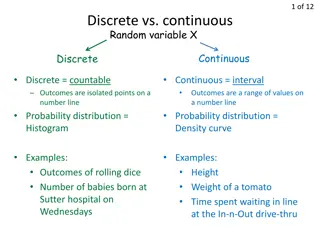Computer Security Essentials: Random Variables and Joint Probabilities
In this informative piece, delve into the world of computer security through the lens of random variables, joint probabilities, and conditional probabilities. Explore concepts such as entropy, uncertainty, and the application of mathematics in ensuring the secrecy of ciphers. Gain insights into the relationships between different events, probabilities, and their dependencies. Enhance your understanding of foundational principles crucial to the art and science of computer security.
Download Presentation

Please find below an Image/Link to download the presentation.
The content on the website is provided AS IS for your information and personal use only. It may not be sold, licensed, or shared on other websites without obtaining consent from the author.If you encounter any issues during the download, it is possible that the publisher has removed the file from their server.
You are allowed to download the files provided on this website for personal or commercial use, subject to the condition that they are used lawfully. All files are the property of their respective owners.
The content on the website is provided AS IS for your information and personal use only. It may not be sold, licensed, or shared on other websites without obtaining consent from the author.
E N D
Presentation Transcript
Entropy and Uncertainty Appendix C Computer Security: Art and Science, 2nd Edition Version 1.0 Slide B-1
Outline Random variables Joint probability Conditional probability Entropy (or uncertainty in bits) Joint entropy Conditional entropy Applying it to secrecy of ciphers Computer Security: Art and Science, 2nd Edition Version 1.0 Slide B-2
Random Variable Variable that represents outcome of an event X represents value from roll of a fair die; probability for rolling n: p( =n) = 1/6 If die is loaded so 2 appears twice as often as other numbers, p(X=2) = 2/7 and, for n 2, p(X=n) = 1/7 Note: p(X) means specific value for X doesn t matter Example: all values of X are equiprobable Computer Security: Art and Science, 2nd Edition Version 1.0 Slide B-3
Joint Probability Joint probability of X and Y, p(X, Y), is probability that X and Y simultaneously assume particular values If X, Y independent, p(X, Y) = p(X)p(Y) Roll die, toss coin p(X=3, Y=heads) = p(X=3)p(Y=heads) = 1/6 1/2 = 1/12 Computer Security: Art and Science, 2nd Edition Version 1.0 Slide B-4
Two Dependent Events X = roll of red die, Y = sum of red, blue die rolls p(Y=2) = 1/36 p(Y=3) = 2/36 p(Y=4) = 3/36 p(Y=5) = 4/36 p(Y=6) = 5/36 p(Y=7) = 6/36 p(Y=8) = 5/36 p(Y=9) = 4/36 p(Y=10) = 3/36 p(Y=11) = 2/36 p(Y=12) = 1/36 Formula: p(X=1, Y=11) = p(X=1)p(Y=11) = (1/6)(2/36) = 1/108 Computer Security: Art and Science, 2nd Edition Version 1.0 Slide B-5
Conditional Probability Conditional probability of X given Y, p(X | Y), is probability that X takes on a particular value given Y has a particular value Continuing example p(Y=7 | X=1) = 1/6 p(Y=7 | X=3) = 1/6 Computer Security: Art and Science, 2nd Edition Version 1.0 Slide B-6
Relationship p(X, Y) = p(X | Y) p(Y) = p(X) p(Y | X) Example: p(X=3,Y=8) = p(X=3|Y=8) p(Y=8) = (1/5)(5/36) = 1/36 Note: if X, Y independent: p(X|Y) = p(X) Computer Security: Art and Science, 2nd Edition Version 1.0 Slide B-7
Entropy Uncertainty of a value, as measured in bits Example: X value of fair coin toss; X could be heads or tails, so 1 bit of uncertainty Therefore entropy of X is H(X) = 1 Formal definition: random variable X, values x1, , xn; so i p(X = xi) = 1; then entropy is: H(X) = ip(X=xi) lg p(X=xi) Computer Security: Art and Science, 2nd Edition Version 1.0 Slide B-8
Heads or Tails? H(X) = p(X=heads) lg p(X=heads) p(X=tails) lg p(X=tails) = (1/2) lg (1/2) (1/2) lg (1/2) = (1/2) ( 1) (1/2) ( 1) = 1 Confirms previous intuitive result Computer Security: Art and Science, 2nd Edition Version 1.0 Slide B-9
n-Sided Fair Die H(X) = ip(X = xi) lg p(X = xi) As p(X = xi) = 1/n, this becomes H(X) = i (1/n) lg (1/ n) = n(1/n) ( lg n) so H(X) = lg n which is the number of bits in n, as expected Computer Security: Art and Science, 2nd Edition Version 1.0 Slide B-10
Ann, Pam, and Paul Ann, Pam twice as likely to win as Paul W represents the winner. What is its entropy? w1 = Ann, w2 = Pam, w3 = Paul p(W=w1) = p(W=w2) = 2/5, p(W=w3) = 1/5 So H(W) = ip(W=wi) lg p(W=wi) = (2/5) lg (2/5) (2/5) lg (2/5) (1/5) lg (1/5) = (4/5) + lg 5 1.52 If all equally likely to win, H(W) = lg 3 1.58 Computer Security: Art and Science, 2nd Edition Version 1.0 Slide B-11
Joint Entropy X takes values from { x1, , xn }, and ip(X=xi) = 1 Y takes values from { y1, , ym }, and ip(Y=yi) = 1 Joint entropy of X, Y is: H(X, Y) = j ip(X=xi, Y=yj) lg p(X=xi, Y=yj) Computer Security: Art and Science, 2nd Edition Version 1.0 Slide B-12
Example X: roll of fair die, Y: flip of coin As X, Y are independent: p(X=1, Y=heads) = p(X=1) p(Y=heads) = 1/12 and H(X, Y) = j ip(X=xi, Y=yj) lg p(X=xi, Y=yj) = 2 [ 6 [ (1/12) lg (1/12) ] ] = lg 12 Computer Security: Art and Science, 2nd Edition Version 1.0 Slide B-13
Conditional Entropy X takes values from { x1, , xn } and ip(X=xi) = 1 Y takes values from { y1, , ym } and ip(Y=yi) = 1 Conditional entropy of X given Y=yj is: H(X | Y=yj) = ip(X=xi | Y=yj) lg p(X=xi | Y=yj) Conditional entropy of X given Y is: H(X | Y) = jp(Y=yj) ip(X=xi | Y=yj) lg p(X=xi | Y=yj) Computer Security: Art and Science, 2nd Edition Version 1.0 Slide B-14
Example X roll of red die, Y sum of red, blue roll Note p(X=1|Y=2) = 1, p(X=i|Y=2) = 0 for i 1 If the sum of the rolls is 2, both dice were 1 Thus H(X|Y=2) = ip(X=xi|Y=2) lg p(X=xi|Y=2) = 0 Computer Security: Art and Science, 2nd Edition Version 1.0 Slide B-15
Example (cont) Note p(X=i, Y=7) = 1/6 If the sum of the rolls is 7, the red die can be any of 1, , 6 and the blue die must be 7 roll of red die H(X|Y=7) = ip(X=xi|Y=7) lg p(X=xi|Y=7) = 6 (1/6) lg (1/6) = lg 6 Computer Security: Art and Science, 2nd Edition Version 1.0 Slide B-16
Perfect Secrecy Cryptography: knowing the ciphertext does not decrease the uncertainty of the plaintext M = { m1, , mn } set of messages C = { c1, , cn } set of messages Cipher ci = E(mi) achieves perfect secrecy if H(M | C) = H(M) Computer Security: Art and Science, 2nd Edition Version 1.0 Slide B-17
